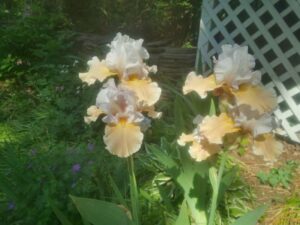 It is certainly possible to have too much of a good thing. My relationship with carrot cake comes immediately to mind. Right now I am in the same situation with the bearded iris, sometimes known as Iris x germanica, in my garden.
It is certainly possible to have too much of a good thing. My relationship with carrot cake comes immediately to mind. Right now I am in the same situation with the bearded iris, sometimes known as Iris x germanica, in my garden.
Many years ago, when my current garden was just getting off the ground, a friend gave me a box of bearded iris rhizomes. They were divisions from her own overcrowded garden, and she was grateful that they were going to a good home. I was grateful because I had beautiful visions of an opulent, iris-filled landscape and lots of bare ground to fill in.
Besides, what right-minded gardener ever turned down free plants?
The rhizomes were not marked as to color or variety, but iris are very easy to move, so I simply planted them in various advantageous sunny positions. Knowing that some of the plants might grow up to three feet tall, I installed the rhizomes in the middle areas of the various new beds.
Then I waited. The following spring my iris sprouted. Some were yellow, with bright golden “beards”. Others were a dramatic dark purple. A few had petals the color of root beer, and some boasted butterscotch-tinted flowers. I might have wished for some pale blue iris, or possibly pink or white, but I figured I could fill in my iris collection as time went on.
And time proceeded to go on. The donated iris flourished—so much so that now I find myself with way too many. The original rhizomes have multiplied religiously every year, becoming crowded and, in some cases, less floriferous. It is past time for some judicious editing.
Anyone who has ever culled a large book or tool collection knows that the editing job is difficult. You know that your intentions are good and the end result will be a vast improvement, but there is always an element of doubt. The irrational but persistent voice that many of us have in the back of our minds says, “You are asking for bad luck. If you get rid of perfectly healthy plants, it will jinx the whole garden.”
Sometimes you can silence that voice by finding good homes for the surplus iris—or books or tools—but too often the resolution to donate the discards to good homes postpones the culling project indefinitely.
I am going to compromise and try to combine necessary editing with guilt reduction. I will dig up most of the bearded iris and put them aside. Once I have done that job, I’ll discard all the rhizomes that are too small or appear to be afflicted with the dreaded iris borer. I will reinstall a few of the remaining rhizomes in their original locations, amending the soil as I go.
Since I have some untenanted sunny space in front of my privet hedge, a few of the rhizomes can go there to prolong the spring flowerfest. The rest will be offered to neighbors, friends and anyone else that I know who might be remotely interested in them. I hope this will take care of the whole problem. I can’t spend hours on end trying to find good homes for my discarded rhizomes. If I think about it, I’ll put out the word on the local social media site. If that doesn’t work, I will put them in a box on the front strip with a sign that says, “Lovely bearded iris, free to good homes.”
Bearded iris are ridiculously easy to grow, as demonstrated by my plants, which, all too frequently, have been fertilized with a combination of drought and neglect. Overall, the plants like rich, well-drained soil and lots of sunshine. Some varieties are more vigorous than others in some places, but generally, clumps should be divided every few years. An overcrowded clump looks like a circle of plants surrounding an empty central space. The empty space is home to rhizomes that have gotten old and woody, or old and mushy, and have stopped producing leaves and flowers. They should be discarded as you do the job of dividing the clumps.
And dividing iris is easy because they are shallowly rooted. Dig all the way around the outside of the clump, and then gently dig under the rhizomes, which are no more than a few inches down. Lift the clump out and pull apart the rhizomes with your hands, making sure that each division has plenty of roots attached. Replant if you have the space, or alert your gardening friends. The prospect of free plants usually arouses at least a bit of interest from fellow gardeners.
Good communication is about intelligent editing. So is good gardening. If only guilt and its fellow traveler, inaction, didn’t intervene so often.
